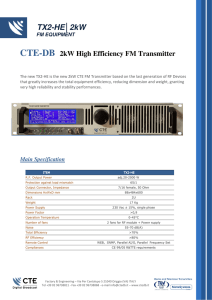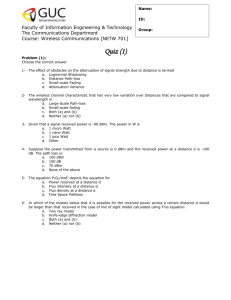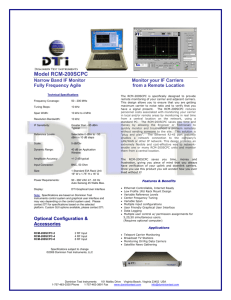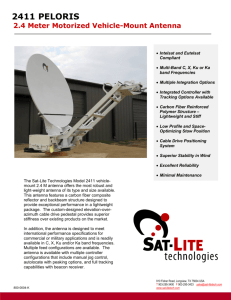Polar Loop Transmitter
advertisement
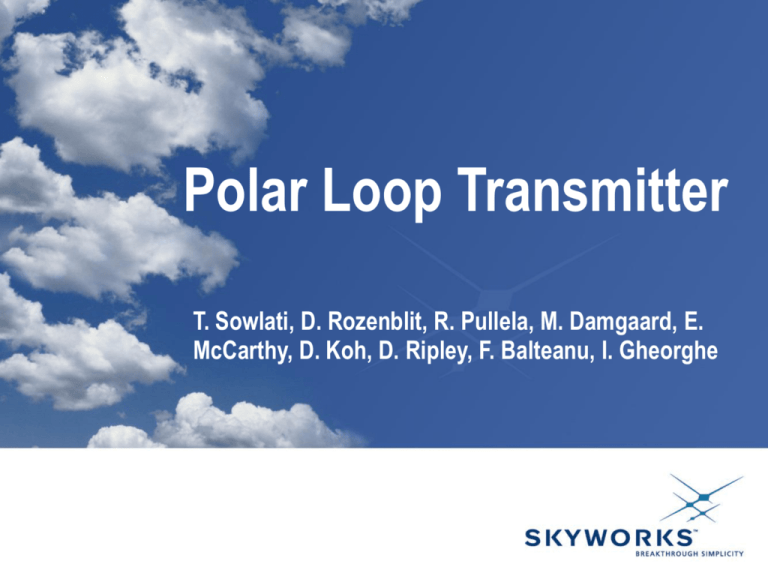
Polar Loop Transmitter T. Sowlati, D. Rozenblit, R. Pullela, M. Damgaard, E. McCarthy, D. Koh, D. Ripley, F. Balteanu, I. Gheorghe Content • Introduction • Architectures for EDGE Transmitter • Polar Loop Transmitter • Measurement results • Conclusion 2 3/14/2016 Introduction GMSK EDGE modulation • 8-PSK with Gaussian filtering • Data rate 3X compared to GMSK • Spectrum very similar to GMSK • 17 dB amplitude variation Q EDGE Q I I 0 2 0 -20 -54dBc -30 -60dBc -40 Power [dB] Power [dB] -10 -2 -4 -6 -50 -8 -60 -10 -70 -12 -80 -600 -14 -400 -200 0 200 Frequency [kHz] 3 3/14/2016 400 600 1000 1050 1100 1150 1200 Time [us] 1250 1300 Introduction (ii) • Low Efficiency PA! -10 -20 Power [dB] • Unlike GMSK, EDGE cannot use nonlinear PA • For EDGE, PA operating point should be ~ 6dB bellow 1dB compression point. • This operating point provides only 3dB margin on Spectral Mask 0 Failure -30 -40 -50 Spectral failure due to Compression & AM-to-PM of 0.8°/dB -60 -70 -80 -600 -400 -200 0 Motivation for our GSM / GPRS / EDGE Transmitter + Preserve high efficiency of the TX chain in GMSK mode + No SAW Filter in TX chain + No mode change in PA between GMSK & EDGE + Improve system efficiency in EDGE 4 3/14/2016 200 Frequency [kHz] 400 600 TX Architectures with Linear PA 1) Superhet up conversion with IQ vector modulator 2) Direct up conversion with IQ vector modulator I I 90° + Q IF VGA PLL SAW Filter PA + 90° Q Isolator Driver PA SAW Filter PLL PLL IF VCO UHF VCO VCO + Well known techniques with simple interface between Transceiver and PA 3) Polar modulator prior to the PA Isolator – Low Efficiency Linear PA for EDGE mode – External Filter to meet noise in RX band – Isolator to maintain EVM under VSWR – Tend to be expensive and bulky solutions 5 3/14/2016 Driver PLL VCO SD Modulator Digital Phase D/A Digital Amplitude Modulator PA Polar with open loop PA amplitude modulation + Very high PA efficiency is possible PA Isolator – Requires linear amplitude control PLL – Sensitive to AM-to-PM in PA – Sensitive to load variations, temperature, supply – Requires isolator after PA to maintain EVM under VSWR – Accurate alignment of AM and PM components is very critical – Dynamic range for power control and power ramping is an issue 6 3/14/2016 VCO SD Modulator Digital Phase D/A Amplitude Modulation Modulator Required amplitude control range: • DCS / PCS > 50 dB • GSM 850/900 >48 dB Polar Loop Transmitter PA +Very high PA efficiency is possible +Phase and amplitude feedback from PA output VCO gain control +Insensitive to AM-to-PM in PA PLL +Insensitive to load variations, temperature, supply, etc. IF +No isolator required to maintain good EVM under VSWR +No pre- or post-PA filtering required to meet TX Noise in RX band 7 3/14/2016 Down-conversion I Q IF Amplitude control loop Modulator Main Challenges: – Stability – Noise Power control Polar Loop Transmitter Block Diagram UHF VCO /M PA RF VCO /N PFD CP T/R Switch LPF1 Limiter2 Error BPF2 LO2 IQ Modulator BPF1 Baseband I & Q input BB VGA D1 Vcntrl LPF2 D2 IF VGA Limiter1 Vapc + Closed Loop Power Control + High Linearity: IM3 < -40dBc + Wide Control Range > 65dB 8 3/14/2016 LO1 PM AM AM & PM + Constant Gain over Control Range + Low AM-PM + Low Noise Characteristics of AM / PM loops Loop Gain Loop BW Gain Margin Phase Margin Attenuation at 20MHz AM Loop 40 dB 1.8MHz > 14dB > 65° > 38dB PM Loop 1.8MHz > 19dB > 65° > 40dB • Dominant poles / zeros are set by external components • Variations in loop bandwidth are mostly due to gain variations • Loop BW ↑ : Design Tolerance↑ • Loop BW ↓ : Noise ↓ 9 3/14/2016 System Simulations AM Loop gain (dB) • Polar Loop Transmitter modeled and simulated using MATLAB, MATHCAD and ADS • EVM is not sensitive to mismatch between AM / PM Loops • Spectral mask degrades due to mismatch between loops Loop Gain Nominal Nom. – 7dB Nom. + 10dB 10 3/14/2016 Spectrum at 400KHz EVM (RMS) ( Icp , Gain , vz) offset, Spec: -54dBc Spec: 9% -63dBc 1.4% -55dBc 2.1% -55dBc 0.8% Spectral Mask at 400kHz Offset (-dBc) EVM (Peak) Spec: 30% 2.9% 4.3% 1.9% Power Amplifier - EDGE Specific requirements • Same GaAs die as GSM PA. Control Gain • No Mode Select between GMSK / EDGE. Control gain variation at max power • Modified Local Power Controller: – Linear Gain Control – Wide Bandwidth Gain Control – Low Noise – No Efficiency Degradation 11 3/14/2016 AM to PM 20 dB (10V/ V) +/- 3 dB 2.5 ° /dB max Process Info & Die Photos • BiCMOS Process: Transceiver / PA Controller 30GHz Ft NPN, 0.35 mm CMOS, 3-layer metal • GaAs HBT Process: PA 25GHz Ft, 2 mm Feature size, 2-layer gold metal Transceiver: 5 mm x 4 mm PA Controller 2 mm x 2 mm 12 3/14/2016 PA Module 8 mm x 10 mm Quad Band GSM / GPRS / EDGE RF Subsystem • Transceiver: – RX = 40mA GSM; 50mA DCS – TX = 85mA – SYNTH = 35mA PA Module Transceiver • PA Controller – TX = 50mA • PA Module – Typical performance Low Band – GSM @ 34.5 dBm = 54% – EDGE @ 28.5 dBm = 35% High Band – GSM @ 31.5 dBm = 45% – EDGE @ 27.5 dBm = 35% 13 3/14/2016 PA Controller Quad Band Evaluation Board GSM Band – EDGE: Max. Required Power at Antenna (27 dBm) 14 3/14/2016 GSM Band – EDGE: Max. Required Power at Antenna (27 dBm) 15 3/14/2016 GSM Band – EDGE: Max. Required Power at Antenna (27 dBm) 16 3/14/2016 GSM Band – EDGE: Max. Required Power at Antenna (27 dBm) 17 3/14/2016 GSM Band – EDGE: 2dB above Max Required Power at Antenna! 18 3/14/2016 19 3/14/2016 960 MHz 935 MHz 914.8MHz TX Noise in RX Band: Highest Channel & Highest Power Level -79dBm Performance under VSWR Requirements: • 6:1 - Maintain the link, EVM and RF spectrum allowed to be corrupted • 10:1 - No device damage 28 2:1 Pout Delivered (dBm) • 3:1 - EVM meet spec, RF spectrum allowed to fail spec Measured power at Antenna under VSWR 3:1 4:1 24 5:1 6:1 8:1 20 10:1 16 0 90 180 VSWR Angle (degrees) 20 3/14/2016 270 VSWR Measurement EDGE Mode EVM under VSWR Variation 2:1 Spec 8 3:1 4:1 6 5:1 4 6:1 2 8:1 10:1 0 0 90 180 270 Max Spec VSWR Angle (degrees) 600KHz Offset (dBc) -45 2:1 -50 3:1 4:1 Spec 5:1 -60 6:1 -65 8:1 10:1 -70 0 21 3/14/2016 90 180 270 VSWR Angle (degrees) 2:1 3:1 -50 Spec -55 4:1 5:1 6:1 -60 8:1 10:1 -65 0 90 180 270 Max Spec VSWR Angle (degrees) Spectral Mask at 600KHz Offset -55 -45 400KHz Offset (dBc) EVM (% rms) 10 Spectral Mask at 400KHz Offset Max Spec Without Isolator: + No degradation of EVM ! + Modulation spectrum within spec up to 4:1 VSWR System Performance Summary – Low Band Modulation / Band Parameter Maximum Output Power GMSK Mode 900 MHz Band EDGE Mode 900 MHz Band 22 3/14/2016 Modulation Spectrum 400 kHz offset, 30 kHz BW 600 kHz offset, 30 kHz BW RMS Phase Error Peak Phase Error Noise 10MHz offset, 100KHz BW Noise 20MHz offset, 100KHz BW Maximum Output Power Modulation Spectrum 400 kHz offset, 30 kHz BW 600 kHz offset, 30 kHz BW RMS EVM Peak EVM 95th percentile EVM Noise 10MHz offset, 100KHz BW Noise 20MHz offset, 100KHz BW Measured Performance 33.5 dBm GSM Requirement 31 dBm min /33 dBm nom -65 dBc -68 dBc 1.4 4.8 -75 dBm -80.5 dBm 29 dBm -60 dBc max -60 dBc max 5 max 20 max -71dBm -79 dBm 24 dBm min / 27 dBm nom -60 dBc -65 dBc 2.9% 11% 5.5% -78 dBm -83.5 dBm -54 dBc max -60 dBc max 9% max 30% max 15% max -71 dBm -79 dBm System Performance Summary – High Band Modulation / Band Measured Performance 30.5 dBm GSM Requirement 28 dBm min / 30 dBm nom Modulation Spectrum 400 kHz offset, 30 kHz BW 600 kHz offset, 30 kHz BW RMS Phase Error Peak Phase Error Noise 20MHz offset, 100KHz BW Maximum Output Power -64 dBc -67 dBc 1.6 6.0 -75 dBm 26.5 dBm -60 dBc max -60 dBc max 5 max 20 max -71 dBm 22 dBm min / 26 dBm nom Modulation Spectrum 400 kHz offset, 30 kHz BW 600 kHz offset, 30 kHz BW RMS EVM Peak EVM 95th percentile EVM Noise 20MHz offset, 100KHz BW -60 dBc -64 dBc 3.8% 13% 7.3% -78 dBm -54 dBc max -60 dBc max 9% max 30% max 15% max -71 dBm Parameter Maximum Output Power GMSK Mode 1800 MHz Band EDGE Mode 1800 MHz Band 23 3/14/2016 Conclusions • A new transmitter architecture has been presented. • Closed AM and PM feedback loops ensure very robust performance. • High PA efficiency by use of saturated operation. • No SAW filter needed to meet TX noise in RX band. • No need for Isolator to maintain good EVM under VSWR. • Meet or exceed all GSM requirements in Quad Band with both GMSK and EDGE modulated signals. 24 3/14/2016


